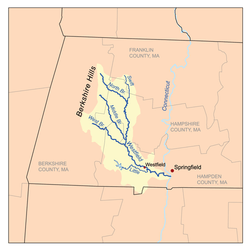Westfield River
The Westfield River is a major tributary of the Connecticut River located in the Berkshires and Pioneer Valley regions of western Massachusetts. With four major tributary branches that converge west of the city of Westfield, it flows 78.1 miles (125.7 km) (measured from the source of its North Branch) before its confluence with the Connecticut River at Agawam, across from the city of Springfield's Metro Center district.[1][2] Known for its whitewater rapids and scenic beauty, the Westfield River provides over 50 miles (80 km) of whitewater canoeing and kayaking, in addition to one of the largest roadless wilderness areas remaining in the Commonwealth.[3]
| Westfield River Agawam River (archaic) | |
|---|---|
 Westfield River in Huntington (the "Main Stem") | |
 The Westfield River and its major tributaries | |
| Location | |
| Country | United States |
| State | Massachusetts |
| Region | Metropolitan Springfield |
| District | Hampden County, Massachusetts |
| Municipality | Westfield, Massachusetts |
| Physical characteristics | |
| Source | North Branch Westfield River |
| • location | Berkshires |
| • coordinates | 42°34′09″N 73°01′54″W |
| • elevation | 1,734 ft (529 m) |
| Source confluence | debouch of the Swift River |
| • coordinates | 42°26′39″N 72°51′31″W |
| • elevation | 922 ft (281 m) |
| Mouth | Connecticut River |
• coordinates | 42°05′03″N 72°35′08″W |
• elevation | 39 ft (12 m) |
| Length | 78.1 mi (125.7 km) |
| Basin size | 517 sq mi (1,340 km2) |
| Basin features | |
| Tributaries | |
| • left | Swift River Dead Branch (East Branch) |
| • right | Middle Branch West Branch Little River |
| Type | Wild, Scenic, Recreational |
| Designated | November 2, 1993 |
The Westfield River is the Connecticut River's longest tributary in Massachusetts, although the Chicopee River's basin is much larger, and contributes more water to the Connecticut. The Connecticut's northern tributary, the Deerfield River, is nearly as long as the Westfield—only 2.1 miles (3.4 km) shorter than the Westfield.
During the mid-20th century, the Westfield River was so polluted that it would change color based on the nature of the contaminant. Today, the river is clean enough for swimming.[4] It is a state and locally managed river featuring native trout fishing and rugged mountain scenery in the context of a historical mill town settlement (at Westfield).
History
On its initial discovery by Massachusetts Bay Colony explorers John Cable and John Woodcock in 1635, the area stretching from the Westfield River's confluence with the Connecticut River to Westfield itself—which, the next year, would all be encompassed in the settlement that came to be known as Springfield—was named the "Agawam River", after the name of the Native American people then occupying the area. Historical literature often refers to Springfield as sitting at the confluence of the Connecticut River with the western Agawam River and eastern Chicopee River. This "Agawam River" is now known as the Westfield River, and should not be confused with the Agawam River in southeastern Massachusetts, which was named in tribute to Springfield's tribe of Native Americans..
Branches of the Westfield River
The Westfield River runs for a total of 78.1 miles (125.7 km). Rising in the Berkshire Hills region of Massachusetts, it flows southeastwardly to join the Connecticut River at Agawam—directly across from Springfield's Metro Center (downtown).[1]
The Westfield River has a 497-square-mile (1,290 km2) drainage area that includes three named branches, which join in Huntington to form the Westfield River's main stem, which flows through Russell into Westfield. The branches are the North Branch (sometimes called the East Branch), which rises in the town of Savoy and flows southeast through Windsor, Cummington, and Chesterfield; the Middle Branch, which rises in the town of Peru and flows southeast through Worthington, Middlefield, and Chester; and the West Branch, which has its origins in Washington and Becket, then flows east through Chester.
The three branches converge in the town of Huntington: the Middle and North Branch (or "East Branch") merge near the hamlet of Goss Heights, 2 miles (3 km) north of their junction with the West Branch (designated a National Wild and Scenic river) at Huntington village. From Huntington, the main stem of the Westfield River flows through Russell and Westfield, then forms the boundary between West Springfield and Agawam before ending at the Connecticut River.
Every April, the Westfield River in Huntington is the home of the Westfield River Whitewater Races, the oldest continuously run whitewater race in the United States.
Portions of the river's watershed have been designated the Westfield Creek Wild and Scenic River, and form part of the National Wild and Scenic Rivers System.
External links
- National Wild & Scenic Westfield River [Map & Segment Descriptions]. Westfieldriverwildscenic.org. Retrieved on 2013-07-15.
- U.S. Geological Survey. National Hydrography Dataset high-resolution flowline data. The National Map, accessed April 1, 2011
- "What's Special". Westfield River Wild & Scenic Committee. Retrieved August 3, 2017.
- "Westfield River Watershed Association - Taylor's History (1953-2002)". www.westfieldriver.org.
- Westfield River Watershed Association
- The Westfield River Watershed Open Space and Recreation Plan Pioneer Valley Planning Commission, 2003.
- USGS site
- Geographic Names Information System feature detail report – ID 619263